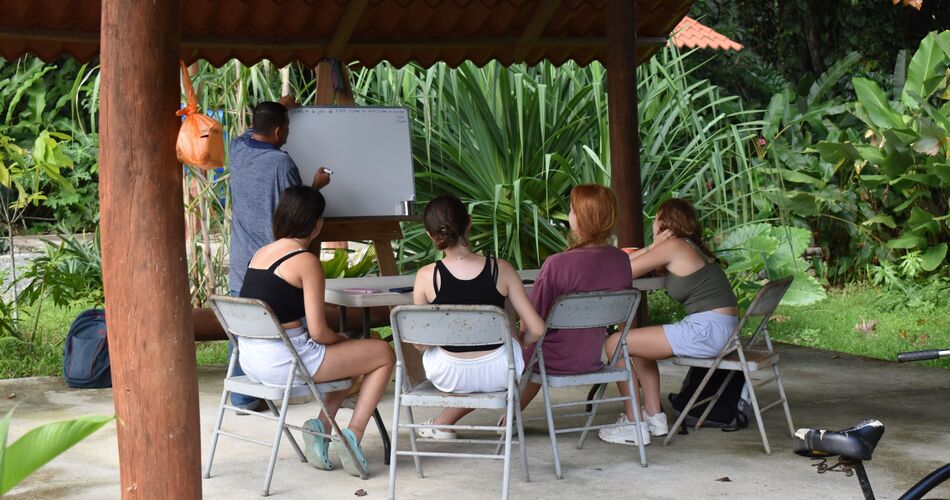What you need to know to ensure your students get the most out of their language immersion trip.
For most students, learning a foreign language is hard work. But what if there was a way to make it easier and, dare we say, fun? Enter language immersion trips where for the majority of the day, students are spending time learning, hearing and speaking in a language other than their native tongue. The benefits of language immersion at an early age are plenty, according to the Center for Applied Linguistics in Washington, DC, including enhancing children’s brain development, expanding their cultural awareness, helping them think more flexibly and increasing job opportunities later in life.
At Travel for Teens, language-focused trips are a part of the more than 100 different programs in some 46 countries that they offer. Since 2003, this family-run company has focused on sharing their passion for travel with teens from around the country. To learn more about language immersion programs, we spoke with Jayden Korber, a program consultant at Teens for Travel.
WHAT AGE/GRADE ARE YOUR LANGUAGE IMMERSION TRIP PARTICIPANTS? We do any age from 7th grade to senior year, which would be 13 to 18 years old.
ARE THESE ORGANIZED TEACHED-LED SCHOOL TRIPS OR MADE UP OF INDIVIDUAL STUDENTS COMING FROM ALL OVER THE COUNTRY? We do both. We partner with teachers, and we will build a whole customized itinerary for them. Additionally, in the summer we have open enrollment, which are like camp programs but abroad with everything from 7 days up to 40.
WHAT LANGUAGES AND DESTINATIONS ARE MOST POPULAR FOR AN IMMERSION TRIP? Most of our language immersion trips are Costa Rica, Spain and France. Those are the ones people love and come back for year after year. This year, all those programs, except for France, are completely sold out. Most of our language programs are 18 students and up to 24 max. If we do a private program, we can do anything from 10 up to 40. We do a ratio of 8 to 1 of kids to staff members.

WHAT ADVICE WOULD YOU GIVE A TEACHER WHO’S INTERESTED IN LANGUAGE IMMERSION TRIPS BUT DOESN’T KNOW WHERE TO START? If they reach out to us, we will set up a meeting between them and our school trip coordinator. It will be someone from the operations side — the paperwork, how many kids do they want, etc. — and someone who will go over what they want out of this program and what experience are the kids looking for. That’s where we get to build the trip from the ground up: destination, activities, accommodations. After that, we will send over a sample itinerary and see how they like it and then from there we will start moving on to setting everything up with the parents.
WHAT MAKES A GREAT LANGUAGE IMMERSION TRIP? First is that the language instruction is individualized. It’s hard to find group of kids that all have the same level. Also, it’s important the kids feel safe and are having fun. Yes, the program is about language and practicing, but you learn best when you’re having fun and immersed in the culture. We will have our classes in the morning, but then we go out and do activities. Having that element of engagement and experiential education while you’re learning the language really puts these programs over the top.
WHAT ARE SOME BENEFITS OF DOING A IMMERSION TRIP LIKE THIS? We’ve had a lot of kids tell us, I’ve taken 2 years of Spanish classes and I learned more in these 14 days then I did back home. The benefit is getting them talking to local people and interacting with the culture as well as the language. It imbeds it in their heads and gives them experiences.
WHAT ARE SOME COMMON MISCONCEPTIONS WHEN IT COMES TO LANGUAGE IMMERSION TRIPS? A lot of families come into it thinking it is going to be strict, and you can only speak Spanish, for example, the whole time. But really it is a lot more hands on than that.
WHAT CRITERIA TEACHERS SHOULD CONSIDER WHEN LOOKING AT COUNTRIES TO VISIT FOR AN IMMERSION TRIP? First, is to figure out where they are interested in. We want to build trips for people that want to go to these places. The affordability aspect is huge to us. A lot of times programs like this can be unattainable to a large group of the population. With our school trips, we try to make them super affordable and doable for the families.
IS THERE AN IDEAL LENGTH OF TIME? Most of our school program are about 10 days, but we can do anything. This year we have school trips running from 7 days to two weeks. In terms of group dynamics on day 3, you hit this flow, where everyone is comfortable with the leaders of the trip, the food and speaking the language. After that day 3, you still have a week where everyone is settled down, over the jet lag, confident and ready to go.
HOW CAN TEACHERS PREPARE THEIR STUDENTS FOR A LANGUAGE IMMERSION TRIP? One thing that is huge is having the teachers go over before where they’re going to go, including the history and culture. That builds this excitement where the kids are on the edge of their seats. The trip really starts the moment they sign up.

WHAT ABOUT TIPS WHEN THEY’RE ON THE LANGUAGE IMMERSION TRIP? We preference every trip with this big speech of rules, but we keep it fun. Whenever we are doing an activity or engaging with each other and out in the public, we ask the kids not to be on their phones. We stay busy on these trips, so there’s not much time where they would want to be on their phones. We always make sure there’s an hour at end of day where they can call home, decompress and have some rest time. For the most part, we really do everything we can to get everyone fully engaged in the program, so they get the most out of it. The other big part is our counselors take a ton of photos of them on our trips. We are taking the photos, so they can just engage in what they are doing.
WAS GETTING THEM OFF THEIR PHONES HARD INITITALLY? It’s easier than you think because the kids are so engaged. It’s cool to see kids today, who are always on their phones and who grew up with their phones, in an environment where you don’t have to tell them that much to get off them. Of course, every once in a while, we have a kid who’s really attached to their phone. We will bring parents in and get to the bottom of how we can help them enjoy the trip the most. It’s not a disciplinary thing; rather it’s getting to the root of it, whether it’s social anxiety or homesickness.
ONCE HOME, WHAT ARE SOME TIPS FOR TEACHERS TO ENSURE THEIR STUDENTS CONTINUE TO GET THE MOST OUT OF THEIR IMMRESION TRIP? What a lot of the teachers will do is include what they learned on the program in the classroom. They will have them pull up a photo from that market in Paris and tell the class about what they purchased, what they ate and how it tasted. Having that element of sharing, maybe with some kids who didn’t get to go on the program, is great. And then re-establishing that learning they already did on the ground whenever they get back home. The trip doesn’t end because you can now convey all your experiences in the language that you learned.
IF SOMEONE WAS NOT SURE ABOUT DOING A LANGUAGE IMMERSION TRIP, WHAT WOULD YOU TELL THEM TO CONVINCE THEM TO DO IT? I would say it’s really going to benefit the students and give them the gift of being able to speak with people from another culture. It’s about drawing the bridge between what they learn in the classroom, why they’re learning it and what does it mean in the real world. Languages live through the people who speak them. Making that connection for kids instills a passion to want to learn more and get better at the language and to keep on traveling. Above and beyond the language skills they learn, just exposing them to the world so that they can see people who live differently from them. Also, for them to see that the world is a big, beautiful place that’s not so scary is a huge part of getting them connected to be global citizens.
For more information on Travel For Teens, visit travelforteens.com
By Lisa Shames
Top photo: Taking flight in Costa Rica. Photo courtesy of Travel For Teens
If you’d like to receive more news about the student travel industry, along with plenty of student travel ideas, be sure to Subscribe to Student Travel Planning Guide for FREE.






